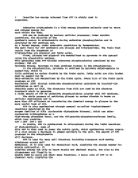How is ATP produced and used in living organisms?
ATP (adenosine triphosphate) is required in all living cells as a continual supply of energy, to be used in processes, which keep the organism alive such as muscle contraction. ATP is made up of three main components, the base (adenine), a phosphate chain (made of three phosphate groups) and a ribose sugar backbone. The energy released from the respiration of Glucose is used to add inorganic phosphate groups to ADP to form ATP. Below is a diagram of ATP.
The first step in the production of ATP and the store of energy is Glycolysis, which occurs in both aerobic and anaerobic respiration. In both cases Glycolysis takes place in the cytoplasm of the cell, because glucose is too big to get in to the mitochondria.
The process starts with glucose (a six carbon sugar) and two ATP molecules needed to start off the process, (as sugars aren't very reactive) the glucose is transferred to another 6 Carbon Sugar (Fructose Bisphoshate). This breaks it down into two 3Carbon Sugars called Pyruvates. Two ATP molecules per Pyruvate is produced through the condensation reaction of a phosphate group called phosphorylation and ADP (adenosine diphosphate) forming ATP. The excess hydrogen ions are removed by the aid of NAD to form one molecule of reduced NAD per pyruvate.
If the organism is anaerobic or when the supply of oxygen is not enough for the energy consumption taking place, the NAD supply must be replenished, which involves oxidising the NAD and transferring the hydrogen to another molecule. This can be done in two ways, through producing Lactic acid or producing Ethanol. Neither of these produces anymore ATP, meaning the product (as four are made but two ATP molecules must be used to start the process) of anaerobic respiration is only two ATP.
ATP (adenosine triphosphate) is required in all living cells as a continual supply of energy, to be used in processes, which keep the organism alive such as muscle contraction. ATP is made up of three main components, the base (adenine), a phosphate chain (made of three phosphate groups) and a ribose sugar backbone. The energy released from the respiration of Glucose is used to add inorganic phosphate groups to ADP to form ATP. Below is a diagram of ATP.
The first step in the production of ATP and the store of energy is Glycolysis, which occurs in both aerobic and anaerobic respiration. In both cases Glycolysis takes place in the cytoplasm of the cell, because glucose is too big to get in to the mitochondria.
The process starts with glucose (a six carbon sugar) and two ATP molecules needed to start off the process, (as sugars aren't very reactive) the glucose is transferred to another 6 Carbon Sugar (Fructose Bisphoshate). This breaks it down into two 3Carbon Sugars called Pyruvates. Two ATP molecules per Pyruvate is produced through the condensation reaction of a phosphate group called phosphorylation and ADP (adenosine diphosphate) forming ATP. The excess hydrogen ions are removed by the aid of NAD to form one molecule of reduced NAD per pyruvate.
If the organism is anaerobic or when the supply of oxygen is not enough for the energy consumption taking place, the NAD supply must be replenished, which involves oxidising the NAD and transferring the hydrogen to another molecule. This can be done in two ways, through producing Lactic acid or producing Ethanol. Neither of these produces anymore ATP, meaning the product (as four are made but two ATP molecules must be used to start the process) of anaerobic respiration is only two ATP.

This is a preview of the whole essay
Teacher Reviews
Here's what a teacher thought of this essay
Overall this is a good solid essay, clearly written and covering the major points. Towards the end it is less well written and looks a little rushed. The last two paragraphs could be extended quite a lot to cover other things on the syllabus. There are a couple of misunderstandings that could be cleared up with some more reading: ideally this essay would also have the names of the textbooks used in a bibliography at the bottom. ****







